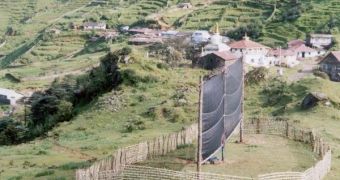Hundreds of millions of people worldwide are affected by drought, and there are places in the world where it hasn't rained for more than five hundred years. Recurring droughts in Africa have created severe ecological catastrophes, prompting massive food shortages.
Two Israeli architects pursuing PhDs at the Technion-Israel Institute of Technology have designed a low-tech device to collect dew from the air and turn it into fresh water, with the potential of making clean, safe water available to millions of people around the world.
The two were inspired by nature, since some lifeforms are the champions at resisting drought and collecting water where it's scarce. The Stenocara beetle, living in the Namib Desert of Africa, one of the driest places on Earth, survives by raising its warty-looking wing covers into the breeze, these being highly hydrophilic and able to collect every water molecule that strikes them. Then water is then pushed upwards and collected on the bumps, where it condenses into tiny drops that roll into the insect's mouth.
Leaves have amazing water collecting abilities too, and survival experts use plastic bags placed around a handful of leaves to collect the condensed water from their surface.
The device - called WatAir and built by Technion Architecture and Building Planning grad students Joseph Cory and Eyal Malka - can extract a minimum of 48 liters of fresh water from the air each day, from only a 315 sq ft unit.
It looks like an inverted pyramid array of panels that collects dew from the air and turns it into fresh water in almost any climate. Depending on the number of collectors used, an unlimited daily supply of water could be produced even in remote and polluted places.
It's very easy to incorporate into both rural and urban landscapes, thanks to its relatively small base, and to the fact that its vertical and diagonal design utilizes gravity to increase the collection areas.
The flexible panels that collect water are easy to collapse when not in use, and provide shelter from rain and heat and play areas for children, making it one of the most accessible applications in poor areas, where large, high-tech devices are not affordable.

 14 DAY TRIAL //
14 DAY TRIAL //